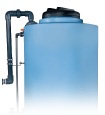Compliance for Chemical Storage Tanks: What You Need to Know About FDA/OSHA/IBC
This article is part 2 of a two-article series that provides an overview of some important industry and regulatory compliance issues you should be aware of when purchasing a chemical storage tank. Read the first article of this series to learn about ASTM and NSF/ANSI/CAN 61 standards.

This series doesn’t cover an all-inclusive list of compliance regulations, but you can use the articles to give you a confident start in understanding the requirements to consider when purchasing a chemical storage tank.
FDA, OSHA, and IBC regulations are among the most familiar compliance requirements in the industry, but they are also commonly misunderstood. Let’s set the record straight.
FDA
Stainless steel has typically been favored as the primary material for storage tanks in the food and beverage industry due to concerns about the potential leaching and bacterial growth associated with polyethylene. However, advancements in resin technology have made polyethylene a viable option.
Poly Processing’s crosslinked polyethylene storage tanks offer options that comply with FDA and CFR regulations while also presenting cost-saving advantages for businesses in this sector.
The FDA and CFR set forth specific guidelines for food and beverage storage under Title 21, parts 176-177, outlining acceptable materials and compositions for tanks. While the FDA does not inspect these storage systems, it is the responsibility of companies to adhere to these guidelines to ensure compliance.
Poly Processing specializes in manufacturing resins that meet these regulatory standards, catering to industry leaders like Campbell's Soups and Anheuser-Busch, who benefit from the seamless, economical construction of our polyethylene tanks.
Poly Processing tanks are utilized in a variety of applications, including wine and beer storage, clean-in-place systems, condiment processing, brining, salt storage, cheese processing, pH adjustment for water treatment, drinking water storage, and ingredient mixing.
For businesses seeking a cost-effective, compliant storage solution tailored to the food and beverage industry, Poly Processing offers expert consultation to create customized solutions.
OSHA
The Occupational Safety and Health Administration (OSHA) has established regulations concerning the storage of chemicals in tanks to ensure the safety and health of workers. Key OSHA regulations relevant to chemical storage tanks involve proper labeling, employee training, and the maintenance of safety data sheets (SDS) for hazardous chemicals. Employers are required to implement measures to prevent chemical spills and releases, ensuring that storage tanks are constructed, maintained, and operated in a way that minimizes risks of exposure and harm.
In addition to federal OSHA regulations, some states have enacted their own standards for chemical storage. These state regulations can vary significantly, often imposing stricter guidelines and requirements than those set at the federal level. For instance, states may mandate specific inspections, additional training for employees, or enhanced safety features for storage tanks.
Consequently, businesses must be aware of both OSHA's federal standards and their respective state regulations to ensure compliance and maintain a safe working environment, potentially requiring different protocols depending on the locations of their operations. Engaging with local regulatory agencies can help organizations stay informed about any additional requirements.
IBC (International Building Code) Seismic and Wind Restraints
When considering the safety of polyethylene chemical storage tanks in the event of a seismic or wind-related event, it is essential to assess the potential seismic/wind activity at the specific tank location.
Poly Processing adheres to the latest International Building Code to design effective restraint systems for these tanks. Unlike rigid stainless steel and fiberglass tanks, which are more brittle and less capable of absorbing seismic forces, polyethylene tanks are ductile, making them less susceptible to damage during earthquakes.
The design of seismic and wind restraint systems is based on various factors, including tank size, fluid weight, location, and the type of chemical stored. Steel clips are typically used to secure the tank to its surrounding area, enhancing safety during seismic or wind events. Unlike fiberglass tanks that often have molded clips that can hide structural damage, inspections for polyethylene tanks are straightforward due to their separate steel restraint systems.
Concrete pad design is another critical aspect, with specific requirements for size and strength to properly support the tank and its seismic/wind restraint systems. Poly Processing offers guidance for engineers and contractors, ensuring pads meet the necessary specifications to safely accommodate tank installations.
If you’re using Poly Processing's Integrally Molded Flanged Outlet® (IMFO®) Tanks, specific pad notching is recommended to facilitate easy drainage without hindrance from the pad design.
With over 30 years of expertise in seismic/wind calculations and systems, Poly Processing emphasizes the importance of consulting with experts for tailored seismic restraint solutions. For additional resources, check out our detailed guides and manuals to support effective installation and maintenance of your storage systems.
Industry News
For over five decades, Poly Processing has been at the forefront of innovation in chemical storage tank design and manufacturing. Reinforcing our commitment to advancing high density crosslinked polyethylene (HDXLPE) tank technology, we are thrilled to unveil our latest update to our vertical storage tank solutions: the 15,500-gallon IMFO tank, the 15,000-gallon Sloped Bottom IMFO tank, and the 15,500-gallon Vertical tank, are all available in specific gravities up to 2.2 design.
These large innovative HDXLPE tanks are designed for exceptional durability, reliable performance, and an extended lifespan across a variety of applications. To enhance protection and prolong service life in oxidative environments, such as those involving sodium hypochlorite, they can be manufactured with our industry-leading OR-1000 engineered resin system, known for its remarkable resistance to oxidative chemicals.
These tanks represent the best engineering and design in the tank manufacturing industry, and they are covered under PPC’s industry-leading warranty.
At Poly Processing, we’re focused on delivering high-quality, forward-thinking solutions to meet the evolving demands of the chemical storage industry.
- June 2, 2025
- Topics: News and Customer Stories, Tank Design and Materials
About Poly Processing
Posts By Topic
Tech Talk Podcast Episodes
Subscribe By Email
Recent Posts
- Maximizing Fill Efficiency: Selecting the Optimal Fill Line System
- Chemical Storage Tanks: A Quick Guide for End Users
- Popular Customization Options for Chemical Storage Tanks
- Understanding Flood Zones Under the IBC: Building Requirements and Insurance Implications
- Choosing Between Steel, Polyethylene, and Fiberglass Tanks: What You Need to Know
Tank Configurator

Find the recommended tank and system components for your chemical storage challenge.
Configure a Tank Package








